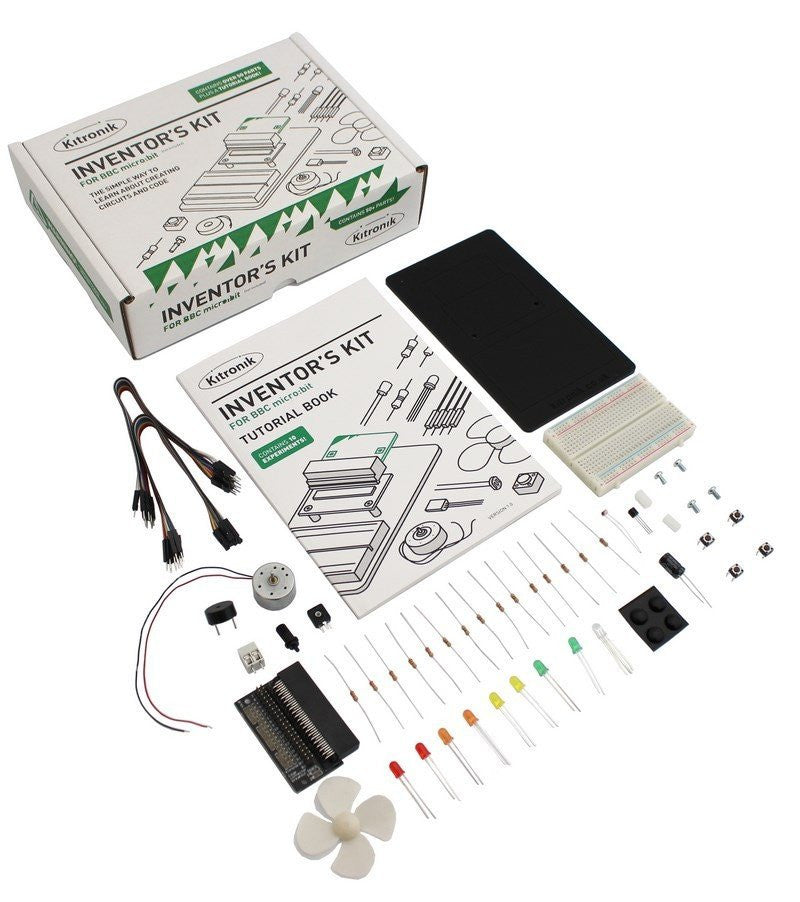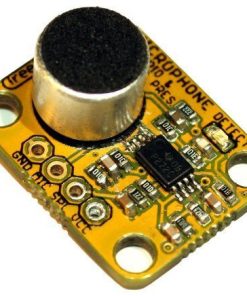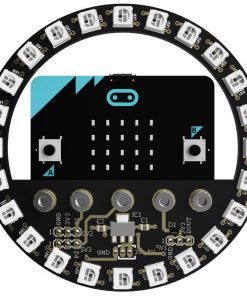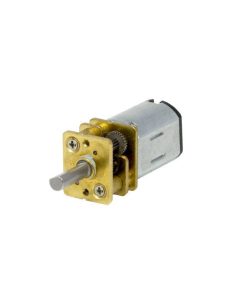Kitronik Inventor’s Kit for the BBC micro:bit Kitronik Ltd
$ 39,55 $ 23,73
Get more from the BBC micro:bit with Kitronik’s incredible Inventor’s kit! The simple way to learn about creating circuits and code.
Please Note: BBC micro:bit is NOT included.
The Kitronik Inventor’s Kit for the BBC micro:bit is a great way to get started with programming and hardware interaction with the BBC micro:bit. This Inventor’s Kit contains everything you need to complete 10 experiments including using LEDs, motors, LDRs and capacitors.
To get you off to a flying start, Kitronik have included an easy to follow tutorial book which guides you through everything you will need to know about programming the BBC micro:bit. You don’t need any experience with programming as the tutorial book will guide you every step of the way. You’ll be programming and creating circuits in no time!
Update: A Python version of the Inventor’s kit is now available. This version’s tutorial book offers step by step guides to all 10 experiments. Experiments 1 – 6 are coded with MakeCode Blocks and experiments 7 – 10 are coded with the MakeCode Python editor. The Python version tutorial booklet has been written especially for this version and will walk the user through creating the code and the circuits. In the original Inventor’s kit experiments 7 – 10 are coded with JavaScript.
Additional Python programming resources:
If you are interested in learning text-based Python, the links below provide Python versions of the above experiments. In addition to the Python web editor, you can get more debugging features by using mu editor or Thonny editor. The Thonny editor comes pre-installed with the Raspberry Pi Operating System (OS); making this kit a great add-on to use with your Raspberry Pi or even older computers running Raspberry Pi Desktop OS.
- There’s a link to some instructional videos and Python hex code here.
- KevinJWalters has made a replica of the complete set of MicroPython source files for this kit here.
This kit can also be used with the Adafruit CLUE – there’s a great Instructables blog post on adapting CircuitPython here.
Inventors Kit Add-On Packs:
On its own, the Kitronik Inventors Kit offers a great introduction to the world of physical computing. Its 12 experiments showcase how code and electronics can combine to create real-world every day practical solutions to situations and problems. Harnessing the power of the elements, using sensory input to make things happen, and using variable input amounts to effect a gradual change are just some of the things you can learn as you progress through the experiments. But why stop there?
In our homes, schools and offices we are surrounded by consumer electronics that at their core, are physical computing devices. Coded electronic devices are everywhere. Many of these devices have been coded to communicate things to us, both visually and audibly. The three add-on packs for the inventors kit have been specifically devised to introduce you to these aspects of practical physical computing.
- ZIP LEDs Add-On Pack for Kitronik Inventors Kit for micro:bit – Most consumer electronics heavily rely on LEDs, as LEDs are a great way of providing instant visual feedback for the user. With this add-on pack, you will learn how to write code to take control of ZIP LEDs and also learn how to make ZIP LEDs respond to input from components such as potentiometers and sensors.
- Noise Pack for Kitronik Inventor’s Kit for the BBC micro:bit – Learn how to manipulate sound, build instruments, amplify your sounds, and how to shape your sounds with Filtering and EQ.
- Digital Logic Pack for Kitronik Inventor’s Kit for the BBC micro:bit – Learn how logic gates work and how they can be used in conjunction with the micro:bit.
The Kitronik Inventor’s Kit for the BBC micro:bit provides a fantastic way of learning how to construct and control electronic circuits. The BBC micro:bit has a selection of pins that are located on the bottom edge of its PCB (see datasheet below for details). By using the specially designed Edge Connector Board for the BBC micro:bit in conjunction with the breadboard (see below), it is easy to use these pins to connect additional components to the BBC micro:bit.
No soldering is required and you can build your first circuit in minutes!
Note:
- This kit requires assembly.
Features:
- No soldering required – build your first circuit in minutes!
- Make 10 experiments included in the provided step-by-step tutorial book.
- All parts are included to conduct the 10 experiments (listed below).
- Breaks out 21 accessible pins from the BBC micro:bit using the Edge Connector Board for the BBC micro:bit (included).
- Small Prototype Breadboard included for fast prototyping.
All of the experiments included in this booklet (listed below) are based on the Microsoft BlockEditor and Microsoft TouchDevelop editor software.
Experiments included in the tutorial book:
- Experiment One: Say ‘Hello’ to the BBC micro:bit.
- Experiment Two: Using an LDR & analog inputs.
- Experiment Three: Dimming an LED using a potentiometer.
- Experiment Four: Using a transistor to drive a motor.
- Experiment Five: Using the accelerometer to control motor speed.
- Experiment Six: Setting the tone with a piezo buzzer.
- Experiment Seven: Wind power.
- Experiment Eight: Making a game using the compass.
- Experiment Nine: Capacitor charge circuit.
- Experiment Ten: Using an RGB LED.
Contents:
- 1 x Perspex Mounting Plate.
- 1 x Potentiometer & Finger Adjust Spindle.
- 2 x Plastic Spacer 10mm.
- 1 x Sticky Fixer for Battery Pack.
- 1 x Small Prototype Breadboard.
- 1 x Terminal Connector.
- 4 x Push Switch.
- 1 x Motor.
- 1 x Transistor.
- 2 x Red 5mm LED.
- 2 x Orange 5mm LED.
- 2 x Yellow 5mm LED.
- 2 x Green 5mm LED.
- 1 x RGB 5mm LED.
- 1 x Fan Blade.
- 5 x 2.2KΩ Resistor.
- 5 x 10KΩ Resistor.
- 5 x 47Ω Resistor.
- 1 x Edge Connector Breakout Board for BBC micro:bit.
- 1 x Miniature LDR.
- 10 x Male to Male Jumper Wires.
- 10 x Male to Female Jumper Wires.
- 4 x Self-adhesive Rubber Feet.
- 1 x 470uF Electrolytic Capacitor.
- 1 x Piezo Element Buzzer.
- 4 x Pan Head M3 Machine Screw.
Requires:
- 1 x BBC micro:bit v1 or V2.
- 1 x Phillips Screwdriver.
- 1 x Terminal Block Screwdriver.
- 1 x Micro USB Cable.
See a video of what’s in the kit here.
| Version | MakeCode and JavaScript labs, MakeCode and Python labs |
|---|
Fast Shipping and Professional Packaging
Because of our long-standing partnership with UPS, FedEx, DHL and many other leading global carriers, we can provide various shipping options. Our warehouse staff is highly trained and will pack the items according to our exact and precise specifications. Before shipping, your goods will be thoroughly examined and secured. We deliver to thousands of customers every day from all over the world. This is a sign of our dedication to being the largest online retailer worldwide. There are distribution centers as well as warehouses located in Europe as well as the USA.
Note: Orders with more than one product are assigned a specific processing period dependent on the particular item.
Before shipping, we will examine the items ordered carefully before shipping. The majority of orders are shipped within 48 hours. The time to deliver varies from 3-7 days.
Returns
The stock is constantly changing and cannot be fully controlled by us due to the involvement of many parties including the factory and our warehouse. This means that the actual stock could alter at any time. Be aware that it is possible that your order could be out of stock after you have made the order.
Our policy lasts thirty days. If you haven't received your item within 30 days, we're unable to offer the option of a refund or exchange.
You are able to return an item when it's unopened and is in the same condition as when you first received it. It should also be returned in its original packaging.
Related products
part



































































